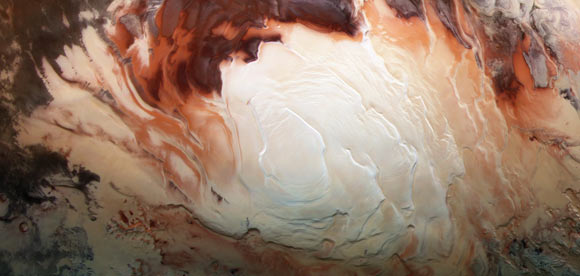Carbon dioxide ice is found in a stack of deposits at the south pole of Mars. These deposits are situated in basins, where they reach more than 1 km thick. Previous work suggested that the carbon dioxide ice should be deposited when the axial tilt of the planet was lower, making the poles colder than they are now; however, the thickness and distribution of this ice should be much thinner than observed if only atmospheric effects are working on the ice. Therefore, the distribution of carbon dioxide ice deposits cannot be explained by atmospheric deposition alone. In a new study, published in the Journal for Geophysical Research: Planets, researchers used glacial modeling and feature analysis to demonstrate that glacial flow better explains the distribution of ice in its present state.

This image, taken on December 17, 2012 by ESA’s Mars Express, shows the icy cap that covers Mars’ south pole, composed of frozen water and carbon dioxide. Image credit: ESA / DLR / FU Berlin / Bill Dunford.
“The carbon dioxide deposits that were first identified in 2011 turn out to be flowing today, just like glaciers on Earth,” said Dr. Isaac Smith, a planetary researcher at York University and Planetary Science Institute.
“Approximately 600,000 years ago, carbon dioxide ice started forming at the Martian south pole.”
“Due to climate cycles, the ice has increased in volume and mass several times, interrupted by periods of mass loss through sublimation.”
“If the ice had never flowed, then it would mostly be where it was originally deposited, and the thickest ice would only be about 45 m thick.”
“Instead, because it flowed downhill into basins and spiral troughs — curvilinear basins — where it ponded, it was able to form deposits reaching 1 km thick.”
“The glaciers have enough mass that if sublimated, they would double the atmospheric pressure of the planet. It’s a stunning quantity, and a 2018 paper measured it most accurately,” he said.
“The longest glacier is about 200 km long and about 40 km across. These are big!”
“That activity is ongoing, but flow rates probably peaked about 400,000 years ago when deposition was greatest. We’re in a slow period because the ice is decreasing in mass, and that slows down glaciers.”
A recent study investigated the flow laws, or strength properties of carbon dioxide ice.
That work found that carbon dioxide ice flows close to 100 times faster than water ice in Martian conditions and on high slopes.
This is why the carbon dioxide ice behaves as glaciers where the rest of the water ice cap that supports it appears stationary.
An analysis of glacial modeling results, using NASA’s Ice Sheet and Sea-Level System Model, adapted by the team to work on Mars and with carbon dioxide, showed that the carbon dioxide ice had not been moved by typical methods.
“Atmospheric deposition would put the ice in a pattern we don’t see. It would be much more evenly spread and thinner,” Dr. Smith said.
“What the glacier interpretation provides is a mechanism to move the ice from high places, into the lower basins that are also at lower latitude.”
“If atmospheric deposition were the only process acting on the ice, then most of it would be found at the highest latitude and highest elevation. That’s just not the case. The ice is flowing downhill into basins, much like water flows downhill into lakes. Only glacial flow can explain the distribution we found in 2018.”
Dr. Smith and colleagues also found several surface features that are very good analogues to features we see on terrestrial glaciers.
“Those include topographic profiles, crevasses, and compression ridges that resemble terrestrial features,” they said.
“This strengthened the conclusions and provided a basis to compare with the models.”
_____
I.B. Smith et al. 2022. Carbon Dioxide Ice Glaciers at the South Pole of Mars. Journal for Geophysical Research: Planets 127 (4): e2022JE007193; doi: 10.1029/2022JE007193







